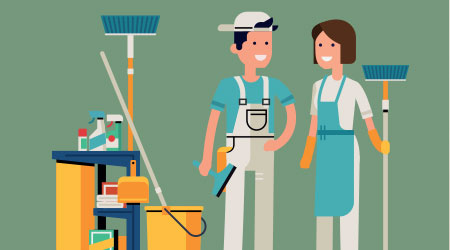The Most Effective Everyday Cleaning Practices: Scrub the Surfaces, Vacuum Carpets, and Keep Clutter at Bay
The Most Effective Everyday Cleaning Practices: Scrub the Surfaces, Vacuum Carpets, and Keep Clutter at Bay
Blog Article
Understanding the Need for Extensively Sanitizing and Sanitizing Frequently Touched Surfaces in High-Traffic Areas
In the world of public health and wellness and safety and security, the thorough disinfection and sanitization of often touched surfaces in high-traffic areas stand as vital actions in stopping the spread of unsafe virus. The relevance of this method extends far past simple sanitation, diving into the realm of disease prevention and neighborhood wellness. By checking out the numerous elements of surface sanitation, from the dangers related to overlooking cleaning protocols to the effective approaches that can be utilized, a clearer understanding arises of the important role these techniques play in protecting public wellness. As we navigate this discussion, it becomes apparent that the implications of complete surface disinfection resound not just within the boundaries of a specific setting yet also reverberate on a more comprehensive scale, affecting the health and wellness of people across varied public setups.
Value of Surface Disinfection
Emphasizing the extensive sanitation of high-traffic surface areas is important in maintaining a sanitary atmosphere and preventing the spread of damaging microorganisms. High-touch surfaces such as door deals with, light buttons, lift switches, and counter tops serve as breeding grounds for viruses and microorganisms. Normal sanitation of these surfaces is crucial to minimize the threat of contamination and transmission of diseases.
By executing a durable disinfection procedure, businesses and institutions can develop a much safer environment for site visitors, customers, and workers. Correct surface sanitation not only mitigates the spread of infectious conditions but additionally instills confidence in the sanitation and security of the premises. This proactive approach demonstrates a dedication to health and wellness, which is particularly vital in high-traffic locations where the likelihood of direct exposure to microorganisms is enhanced.
Moreover, surface area sanitation plays a crucial role in overall infection control techniques. Incorporated with hand hygiene practices, putting on masks, and maintaining physical distancing, complete sanitation of high-touch surfaces creates a thorough protection against the transmission of damaging microbes. Prioritizing surface area sanitation is an essential component of a holistic approach to health and wellness and security in common spaces.
Threats of Ignoring Cleaning Practices
Disregarding comprehensive sanitation of high-traffic surfaces significantly increases the risk of microbial and viral contamination, posturing a significant risk to the health and wellness of people often visiting these spaces. Failure to implement proper cleaning techniques can lead to the accumulation and spread of harmful pathogens, including bacteria and infections, on frequently touched surface areas such as doorknobs, hand rails, elevator switches, and countertops.

Additionally, disregarding the relevance of comprehensive cleaning not just jeopardizes the well-being of people however likewise weakens initiatives to preserve a sanitary and clean environment. It is vital to acknowledge the relevance of appropriate disinfection methods in avoiding the spread of infections and securing public health and wellness.
Effective Disinfection Techniques
To maintain ideal sanitation and lower the threat of contamination on high-traffic surface areas, utilizing effective sanitation techniques is essential. One of the most effective and typical disinfection approaches is using chemical anti-bacterials.
Another effective approach is using UV-C light. UV-C light has been useful reference revealed to be effective in killing a wide variety of bacteria by interrupting their DNA framework, hence preventing them from reproducing. It is essential to make use of UV-C light appropriately, making sure that the correct intensity and direct exposure time are used to attain the wanted sanitation results.
Furthermore, utilizing vapor cleansing as a disinfection technique can be very efficient, specifically on surface areas that are heat-resistant. Steam can permeate porous surface areas and eliminate microorganisms, infections, and various other microorganisms properly. When utilizing steam cleansing, it is very important to ensure that the surface area reaches the required temperature level for a sufficient quantity of time to assure proper sanitation.
Effect On Public Health
The maintenance of high criteria of sanitation and disinfection on high-traffic surfaces plays an essential function in securing public health and wellness. Frequently touched surface areas in areas with high footfall, such as doorknobs, handrails, lift buttons, and restroom facilities, offer as breeding premises for harmful microorganisms.
Efficient hygiene techniques not just safeguard individuals from falling ill yet additionally contribute to the overall health of culture. Public health and wellness authorities stress the relevance of maintaining clean settings to protect against episodes and consist of the spread of ailments. In high-traffic locations like airport terminals, institutions, health centers, and public transport systems, the influence of rigorous disinfection steps can not be downplayed. Focusing on the sanitization of often touched surface areas click here for more info is a positive approach to advertising public health and boosting the security of people in common areas.
Implementing Normal Cleansing Protocols
Promptly setting up and sticking to a constant timetable of cleansing protocols is vital for keeping the sanitation and safety and security of high-traffic surfaces. Routine cleaning methods are essential in stopping the buildup of germs and pathogens on often touched surfaces, especially in areas with high foot website traffic. By applying an organized method to cleaning, companies can properly reduce the risk of disease transmission and produce a much healthier atmosphere for workers, consumers, and the public.
To establish a reliable cleaning schedule, it is crucial to identify high-traffic locations that need constant attention. These areas might consist of doorknobs, handrails, lift switches, toilet facilities, and shared tools. Executing a regular cleaning program that targets these surfaces several times a day can substantially minimize the spread of hazardous germs and viruses.
Furthermore, using ideal cleansing agents and anti-bacterials is crucial to guaranteeing that surface areas are completely sterilized. Routine training of cleaning up team on correct cleansing techniques and the value of adherence to the cleansing schedule is likewise vital in keeping a hygienic setting. By focusing on consistent cleansing protocols, organizations can promote the wellness and health of people who communicate with these high-traffic surfaces.

Verdict
In conclusion, it is vital to focus on extensive sanitation and sanitization of regularly touched surfaces in high-traffic locations to prevent the spread of unsafe microorganisms and maintain public health and wellness. Disregarding correct cleaning methods can enhance click this link the risk of contamination and transmission of diseases. By implementing normal cleaning methods and using efficient sanitation techniques, we can create a much safer atmosphere for everybody (Scrub the Surfaces). It is essential to recognize the importance of preserving clean surfaces in high-traffic locations to ensure the well-being of the community.
In the world of public wellness and safety and security, the thorough sanitation and sanitization of frequently touched surfaces in high-traffic locations stand as vital steps in protecting against the spread of harmful microorganisms. By discovering the various aspects of surface sanitation, from the threats associated with disregarding cleansing methods to the efficient approaches that can be employed, a more clear understanding emerges of the vital role these techniques play in securing public health.Additionally, using heavy steam cleansing as a sanitation method can be extremely effective, especially on surfaces that are heat-resistant. When utilizing steam cleansing, it is essential to make sure that the surface area gets to the needed temperature for an adequate amount of time to guarantee appropriate disinfection.
In final thought, it is vital to prioritize detailed disinfection and sanitization of frequently touched surface areas in high-traffic locations to avoid the spread of harmful virus and maintain public wellness.
Report this page